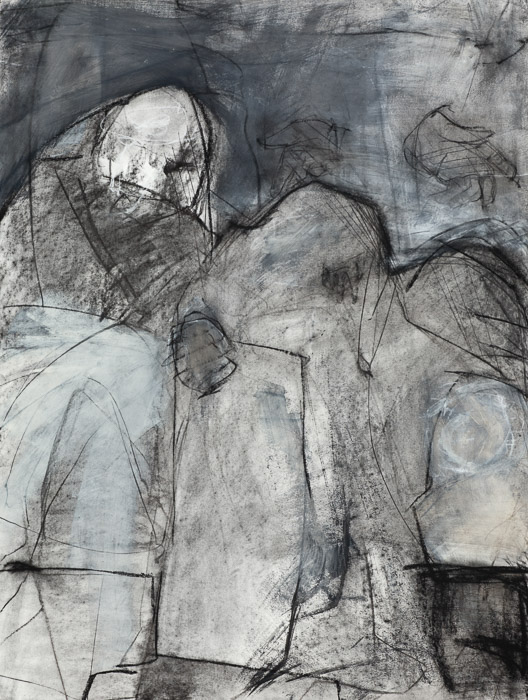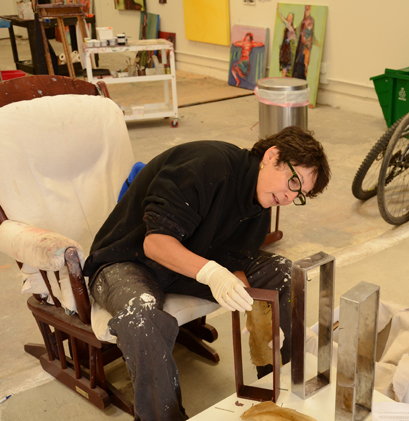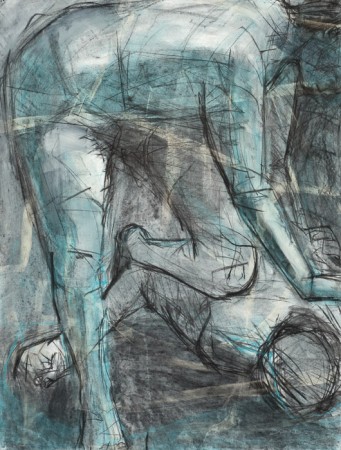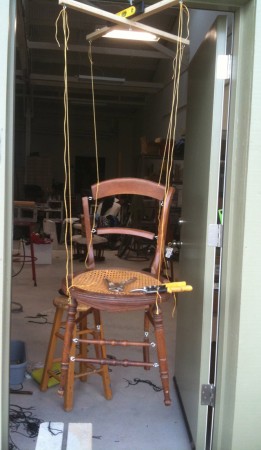cleaning the studio...
...and other adventures in artstudio happenings
A neighbor discarded a metal table base, which I have now refashioned into a new welding table by strengthening it to support a 325-pound 1/4″ steel plate. Very nice! I have wonderful studio neighbors who are generous with their time and assistance–and their discards, and their forklift!

This is one of those studio additions that you don’t know you need until you have it. I was reasonably happy with my smaller table, but this one will be a real luxury. All that space… 4’x8′ of space! I am just itching to get some work done on it, but Open Studios starts this weekend so the last thing I should be doing in my clean studio is welding. It will have to wait.
You can see a large drawing in the background that is ready for Open Studios. Stop by and take a look around. I will be open from 11am-5pm, Saturday and Sunday, at Mission Industrial Studios in Santa Cruz.
open studios 2011
Coming up very soon is Open Studios 2011:

Am I ready? Most certainly not. My studio is a mess, but it is immeasurably more interesting to work on artwork than to work at cleaning the studio. But I will clean it–clean enough for visitors–and I’d love to see you there! Here is a preview, but I promise the ladders and clutter will be out of the way …

virtue and vice
On to Caravaggio. I’m a great admirer, but I know he has his detractors. “Too theatrical!”. “Painted in front of a backdrop, no sense of defining place”. Ok, ok, perhaps true, but perhaps that theatricality is what I like so much about his work.
Mind you, I’m not an admirer of the man, just the paintings. His own life sounds sordid. He killed a man (under unknown circumstances, so let’s give him the benefit of the doubt). He was arrested on many occasions for various crimes, and more than once fled the region rather than stand trial. After being made a knight of the order of St. John of Jerusalem in Malta, he was then expelled from the order (maybe under extenuating political/social circumstances). His life ended, supposedly by illness, as he was on his way to Rome to receive a papal pardon for the earlier murder.
On the other hand, Caravaggio did quite a bit that I do find admirable. He scandalized the art establishment at the time by working directly in oils instead of starting his paintings with preparatory drawings, as was the custom of the time. Studies of his paintings show that he did do quick incised sketches as he worked, with no evidence of an underdrawing.
He scandalized the religious establishment at the time by using street thugs and prostitutes as models, even while pursuing his extreme form of realism. This meant that the people in his paintings were recognizable, and many paintings were rejected by patrons because the models were seen as unfit to portray such sacred scenes. It’s interesting to note that the rejected paintings were typically snapped up immediately by another buyer.
I’ve read reports, too, that he was rude and obnoxious with other artists. He was charged with slander by his fellow painter Giovanni Baglione (whose revenge included depicting Caravaggio as the devil in his painting Sacred Love Versus Profane Love). He supposedly mocked and taunted the painters of Sicily while in exile there.
But, since I’m an admirer of his work, I thought I’d use his paintings as source material for drawings. This proved difficult, perhaps because the paintings are paintings, not painted drawings.
I chose the painting David and Goliath mainly for it’s composition with that strong rectangle of legs-back-arms, but as I worked with the painting I started to see the subtlety of the David figure, with his slight turn of the body and twist in the trunk. And then that head of Goliath in the foreground is so odd and ambiguous, right where the head should be but facing in the wrong direction, out towards the viewer.
I’ve done two drawing so far from this painting, and I’m just starting to realize what it is that I’m after. I’m not trying to copy Caravaggio…I am trying to translate his lights and darks into a drawing language of lines, and I’m playing with a sort of ‘there and gone’ line.
drama and intrigue and narrative
What I love about Tintoretto are all those moving, writhing figures. Everyone in the picture plane is twisted in one direction or another, foreshortened to some degree. Figures grab and hold onto each other. There is drama and intrigue and narrative.
This painting, The Crucifixion, is a case in point. The crucifixion of the title is centrally located in the picture plane, and the Christ figure is glowing and isolated, but look around him at the rest of the picture plane. So much activity!

Tintoretto, The Crucifixion, 1565

Detail of The Crucifixion by Tintoretto, 1565
Using this painting for source material for drawing or painting, one could be busy for years. There is so much information there that it’s difficult to know where to start.
I myself focused on a specific figure in the lower-mid-left, that of a man helping to hoist up the cross of an accused thief. The figure itself, isolated from the rest of the picture, seems to be weighed down by the wooden cross. Or maybe he’s drowning and grabbing that piece of wood for his life. This little section of the painting could stand up on its own as a painting.Here’s my drawing, which, admittedly, takes very little from the Tintoretto. Some other narrative comes out in the drawing process. I’ve learned to not question it too much, and just let it be.

Untitled Drawing, based on Tintoretto’s The Crucifixion, Mixed Media on Paper (Charcoal, Chalk Pastel, Acrylic Paint), 38″ x 50″, 2011
light and shadows
More drawings soon, but first this photo I’ve been meaning to post for a while…
This is R.R. Jones photographing my piece Bridge of Sighs. Lit correctly, this piece has a yellow shadow which is integral to the piece. As you can see in the following photo, Ron got excellent results with his special touch.

This piece is one of three that I have in the upcoming mixed-media show at the Santa Cruz Art League, Mix It Up. If you’re local, come to the reception this Saturday, 3-5pm.

fertile ground
Titian, the great master, provides fertile ground with which to work.
This particular painting, The Madonna Pesaro, has been on my mind for years. In my university days, I wrote a paper musing about the way that he turned an otherwise-static donor-family-in-the-corner grouping into a voyeuristic experience for the viewer, all by a simple turn of the head. Because of that outward-looking child in the donor grouping, you’re not only looking at them, you’re looking in at them and they’re looking back out at you! Clever little device.
I’ve written in the past about how I like to clump figures together (see huddled masses). You can see the mountain of figures in the Titian painting. This particular painting has such a beautiful composition, and the way that the figures all overlay each other lead my eye swirling through the painting, resting on that child’s face, and moving back around again…in my mind, he’s reached perfection in this painting.
Despite the perfection of the painting, or maybe because of it, on Day 2 of the drawing workshop I used this Titian painting as my source material. I worked with that donor grouping of the lower right corner. I originally wanted to focus on that child, but the drawing went through a number of changes and the figures became more and more abstracted. I just about lost the child, so that will have to wait for another drawing.
In the end, I don’t know…is it still figurative? It matters not, in any case. The drawing is finished, and it holds some amount of interest for me, and leads me off in another direction.

Untitled Drawing, based on Titian’s Pesaro Madonna, Charcoal/Chalk Pastel on Paper, 50″ x 38″, 2011
large-scale drawings
I just took a large-scale drawing workshop taught by my friend and fellow artist Claire Thorson. It was a wonderful class, and Claire is truly a gifted teacher. She created a classroom environment in which it felt safe to experiment, and gave us the tools to do so.
People ask, “why take a class?”, but that’s precisely why…to be given not just the freedom but the imperative to explore new directions, with no thoughts about how it might fit into my other work. Whatever it is that I explore in a class will end up in my studio work in some form or another. I always find something that ‘sticks’.
So what ‘stuck’ from this class? First and foremost, I was reminded of how much I love to draw. I do draw regularly, though not as often as I have in the past. I’m not sure why that is, other than that whole thing about painting being a jealous mistress.
What I love about drawing is this: the feel of charcoal on paper, the mark-making, the line and tone and limited color. That evocative sense that comes so naturally to drawings. As with many people, drawing was my first love affair with art-making.
We worked on big drawings, starting with 38″x50″ and progressing to 5’x12′! I found that I was so very comfortable drawing in a large format.
Here’s my first drawing from the workshop. Claire provided us with several different photocopies to use as source material, immediately removing us from our usual working methods. I looked at all the source material at the same time, but specifically looked at hat shapes in a Bruegel piece. I was working in a non-figurative manner, but I kept seeing a figure in it, so I turned it upside-down and it still looked like a figure. At that point, I shrugged my shoulders and made myself consider it purely as a drawing, whether or not it was going to be figurative, and upside-down became right-side-up. But if you turn your screen upside-down, maybe you’ll prefer it in the original orientation?

Untitled Drawing, Chalk Pastel on Paper, 50″ x 38″, 2011
by way of explanation
Look, I haven’t disappeared entirely, I’ve just been really busy. More on all that later (and lots of new work to show), but for the time being you get two photos.
This is the current state of my studio. That pile of photos is what I call my source material midden. Lots of seemingly-random photos to pick through. I keep them in a pile like that because it’s easier to sift through them. And they’re always there in my peripheral vision while I paint.

And I’ll be in a First Friday opening tomorrow at the R. Blitzer gallery, complete with 4 paintings of mine.
There is a Wine Walk that is happening during First Friday this month, and R. Blitzer is participating. If you’re in this area, please come from 6-9pm on Friday, August 5, and enjoy the art and wine!

a chair is a chair is a chair
A chair is a chair is a chair… unless it’s my latest project, a chair-ionette (thank you Tom Maderos, for the name of the thing). It’s not pretty, but it’s going to eventually be functional. Making a marionette out of a chair is more tricky than one would think. The back is heavier than the front, so at the moment this one is kept in balance with two pairs of pliers on the seat. Note the level on the top crossbar.
But I’m slowly figuring it out. In the end, it will be functional, and balanced, I can promise you that. Not pretty, though.
I have to work on it in my open doorway to reach it, so my studio neighbors think I’m crazy. “Don’t you know you can just go buy a chair?!? You don’t need to patch that one up!”
I’ve begun to think of the chair as a disarticulated skeleton that needs to be made whole and functional again. Or sort of. With flaws, but also now animate.
The good news is I have four more chairs just like this one waiting in the wings.
and now for something completely different

Photo by Ruth Rabinowitz
People who know me as a painter don’t always know that I also do sculpture. I tend to primarily work in one medium or the other for months at a time, and I am just now straying back into sculpture after having been painting for a few months.
I do figurative painting, but I have no interest in doing figurative sculpture. The two bodies of work are part of a continuum, though. In painting I’m translating a 3-dimensional figure to a flat picture plane. In sculpture I’m translating a non-dimensional idea to a physical object. The work may look different, but the underlying premise is the same… it’s the translation that I’m interested in.
It’s also satisfying to work with my hands, creating an actual object. The ‘object-ness’ of sculpture is vastly appealing to me. And sometimes metal feels more malleable than paint. (truly!)
Here’s the newest sculpture, photographed just last week. Two views, different lighting, to show both the translucency and sculptural qualities of the rawhide.









